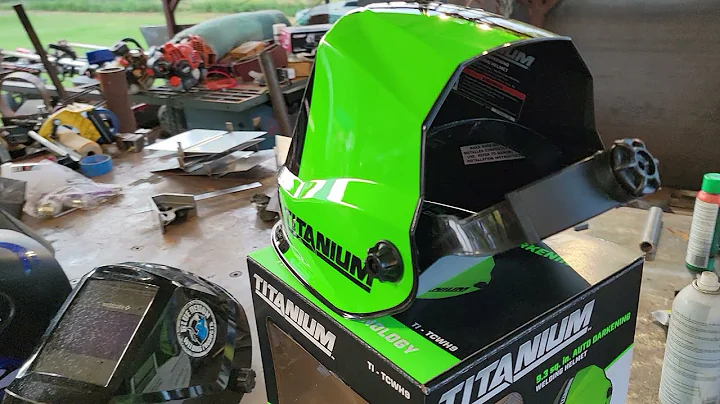Master the Art of Producing High-Quality Bales with Vermeer 504 R-series Balers
Table of Contents
- Introduction
- Factors to Consider for Making a Good-Quality Bale
- Windrow Shape
- Pickup Reel Height
- Net Tension
- Hydraulic Pressure
- Adjusting Net Tension on 504R Premium
- Adjusting Hydraulic Pressure on 504R Premium
- Conclusion
Factors to Consider for Making a Good-Quality Bale
In order to produce a high-quality bale, several factors need to be taken into consideration. These factors include the shape of the windrow, the height of the pickup reel, the tension of the net, and the hydraulic pressure applied to the bale. By optimizing these elements, farmers can ensure that their bales are dense, tightly wrapped, and of superior quality.
Windrow Shape
The shape of the windrow plays a crucial role in the baling process. A well-shaped windrow allows for efficient hay collection and rebalancing throughout the bale chamber. Ideally, the windrow should be wide enough to match the full width of the bale chamber, enabling a straight down driving motion without the need for weaving or compensating. However, if the volume of hay is insufficient, the windrow can be adjusted to half the size of the bale chamber, necessitating weaving to maintain a consistent flow of hay into the baler. The windrow shape directly impacts the density and uniformity of the resulting bale.
Pickup Reel Height
Proper adjustment of the pickup reel height is critical to ensure optimal hay collection while avoiding unnecessary damage to the ground or leaving hay behind. It is recommended to set the teeth of the pickup reel approximately 1.5 inches above the ground when pointing straight down. This allows for efficient hay intake without excessive digging or waste. Maintaining the correct pickup reel height promotes the intake of high-quality hay, resulting in more consistent bales.
Net Tension
The tension of the net wrap significantly influences the quality and stability of the bale. A tightly wrapped bale retains its shape, protects the hay from external elements, and ensures easier handling and storage. On the 504R Premium baler, net tension can be adjusted using the brake system. The brake pad exerts pressure on the drum, stretching the net as it turns. By modifying the tension using the T-bolt and spring, farmers can achieve the desired tightness. It is crucial to find the optimal tension that prevents net breakage while tightly wrapping the bale.
Hydraulic Pressure
The hydraulic pressure applied to the bale has a direct impact on its density and tightness. Proper adjustment of the hydraulic pressure ensures that the bale remains compact and consistent from the core to the outer layers. The density gauge on the side of the baler provides an indication of the pressure exerted. Running the pressure in the mid to upper range of the green scale is generally recommended, but adjustments can be made based on personal preferences and specific hay types. Finding the right hydraulic pressure contributes to the formation of high-quality bales.
Adjusting Net Tension on 504R Premium
To achieve the desired net tension on the 504R Premium baler, the following steps can be followed:
- Locate the brake pad and drum area where the net is fed onto.
- If the net tension is too loose, adjust the tension by loosening the jammed nut.
- Increase the tension by turning the T-handle clockwise.
- Observe the lengthening of the spring, indicating the addition of tension to the netwrap brake.
- Measure the tension using the provided decal for reference.
- Make further adjustments if necessary, ensuring the net tension is at an optimum level.
- Check the net tension by making another bale and observing the tightness of the net on the bale and any signs of breakage or stress on the netwrap attachment.
Adjusting Hydraulic Pressure on 504R Premium
To adjust the hydraulic pressure on the 504R Premium baler, follow these steps:
- Locate the density gauge on the side of the baler.
- If the bale density is too loose, loosen the density adjustment mechanism.
- Increase the pressure by turning it clockwise.
- Observe the movement of the needle on the gauge to gauge the pressure applied.
- Aim to run the pressure in the half to three-quarter top part of the green scale for optimal density.
- Make adjustments based on personal preferences and specific hay requirements.
- Check the needle position after making adjustments by opening the tailgate and observing the gauge reading.
Conclusion
Producing high-quality bales requires careful attention to various factors, including windrow shape, pickup reel height, net tension, and hydraulic pressure. Ensuring a well-shaped windrow, optimal pickup reel height, appropriate net tension, and suitable hydraulic pressure leads to denser, tightly wrapped bales of superior quality. By following the adjustment guidelines specific to the 504R Premium baler, farmers can optimize the baling process and produce consistent, high-quality bales.
Highlights:
- Windrow shape impacts bale density and uniformity.
- Proper pickup reel height prevents ground damage and hay waste.
- Adjusting net tension ensures tight and stable bales.
- Hydraulic pressure influences bale density and tightness.
FAQ
Q: Can I adjust the net tension and hydraulic pressure on other baler models?
- A: The adjustment process may vary between different baler models. Refer to the user manual or contact the manufacturer for specific instructions.
Q: What should I do if the net breaks during baling?
- A: If the net breaks consistently, check the net tension and make adjustments as necessary. Additionally, ensure that the netwrap attachment is functioning properly.
Q: How can I determine the optimal hydraulic pressure for different types of hay?
- A: The optimal hydraulic pressure may vary depending on the type of hay and personal preferences. It is recommended to experiment with different pressures and observe the resulting bale density and tightness.
Q: Are there any additional factors to consider for making high-quality bales?
- A: While the factors mentioned in this article play a crucial role, factors like moisture content, bale size, and storage conditions should also be considered for producing high-quality bales.
Q: What are the benefits of producing high-quality bales?
- A: High-quality bales offer improved longevity, easier handling, and better preservation of hay quality, leading to increased livestock feed efficiency and reduced wastage.







